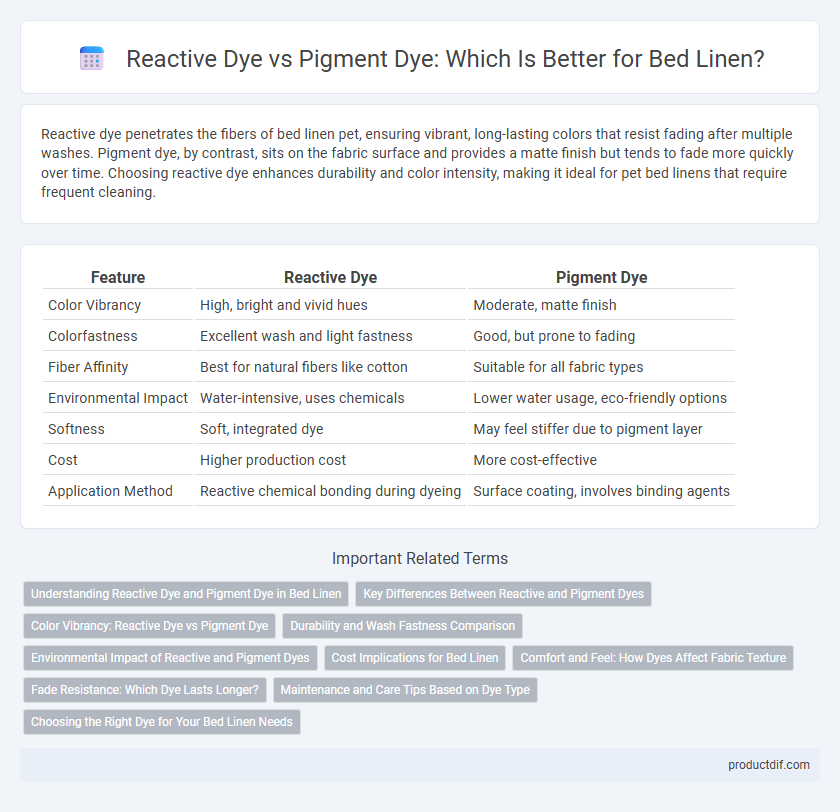Reactive dye penetrates the fibers of bed linen pet, ensuring vibrant, long-lasting colors that resist fading after multiple washes. Pigment dye, by contrast, sits on the fabric surface and provides a matte finish but tends to fade more quickly over time. Choosing reactive dye enhances durability and color intensity, making it ideal for pet bed linens that require frequent cleaning.
Table of Comparison
| Feature | Reactive Dye | Pigment Dye |
|---|---|---|
| Color Vibrancy | High, bright and vivid hues | Moderate, matte finish |
| Colorfastness | Excellent wash and light fastness | Good, but prone to fading |
| Fiber Affinity | Best for natural fibers like cotton | Suitable for all fabric types |
| Environmental Impact | Water-intensive, uses chemicals | Lower water usage, eco-friendly options |
| Softness | Soft, integrated dye | May feel stiffer due to pigment layer |
| Cost | Higher production cost | More cost-effective |
| Application Method | Reactive chemical bonding during dyeing | Surface coating, involves binding agents |
Understanding Reactive Dye and Pigment Dye in Bed Linen
Reactive dye forms a strong chemical bond with cotton fibers in bed linen, resulting in vibrant, long-lasting colors that resist fading after multiple washes. Pigment dye, by contrast, coats the fabric surface without penetrating fibers, producing a softer, vintage look but with less colorfastness and potential for fading over time. Choosing between reactive and pigment dyes depends on desired durability, color vibrancy, and fabric feel preferences for bed linen.
Key Differences Between Reactive and Pigment Dyes
Reactive dyes chemically bond with cotton fibers, providing vibrant colors and excellent wash fastness ideal for bed linen. Pigment dyes adhere to the fabric surface using binders, offering a wider color range but lower durability and tendency to fade over time. Reactive dyes are preferred for their long-lasting, vivid colors in high-quality bed linens seeking both comfort and aesthetic appeal.
Color Vibrancy: Reactive Dye vs Pigment Dye
Reactive dye deeply bonds with cotton fibers, producing vivid and long-lasting color vibrancy ideal for bed linen that remains bright after multiple washes. Pigment dye, unlike reactive dye, rests on the fabric's surface, resulting in softer hues that may fade faster over time but offer a vintage, washed look. For bed linen aiming for intense and durable coloration, reactive dye is the preferred choice due to its superior colorfastness and brightness.
Durability and Wash Fastness Comparison
Reactive dye offers superior durability and excellent wash fastness for bed linen, as it chemically bonds with cotton fibers, preventing color fading after multiple washes. Pigment dye, while versatile and vibrant, tends to sit on the fabric surface and can fade more quickly with frequent laundering. Choosing reactive dye ensures longer-lasting color retention and maintains the textile's quality over time.
Environmental Impact of Reactive and Pigment Dyes
Reactive dyes chemically bond with cotton fibers, resulting in less dye runoff and lower water pollution during laundering compared to pigment dyes. Pigment dyes, while versatile, rely on binders and resins that can contribute to higher levels of microplastic pollution and require more water-intensive washing processes. The environmental footprint of reactive dyeing is generally considered smaller due to its better fixation rates and reduced wastewater contamination.
Cost Implications for Bed Linen
Reactive dye offers superior colorfastness and vibrant hues for bed linen but comes with higher processing costs due to prolonged fixation times and water usage. Pigment dye is more cost-effective, requiring less water and energy during production, making it a budget-friendly option for large-scale bed linen manufacturing. However, pigment-dyed bed linens may experience reduced durability and color retention compared to reactive-dyed alternatives.
Comfort and Feel: How Dyes Affect Fabric Texture
Reactive dye penetrates fabric fibers, creating a soft, breathable texture that enhances comfort in bed linen. Pigment dye coats the fabric surface, often resulting in a stiffer feel that may reduce softness over time. Fabrics treated with reactive dyes maintain a smooth, natural hand, making them ideal for cozy, comfortable bedding.
Fade Resistance: Which Dye Lasts Longer?
Reactive dyes chemically bond with cotton fibers, offering superior fade resistance and vibrant colors that endure multiple washes without significant fading. Pigment dyes, which coat the fabric surface rather than penetrate fibers, tend to fade faster due to weaker adhesion and less colorfastness. For bed linen exposed to frequent laundering and sunlight, reactive dye ensures longer-lasting color retention and durability.
Maintenance and Care Tips Based on Dye Type
Reactive dye bed linens require gentle washing in cold water to prevent color fading and are best maintained with mild detergents to preserve vibrancy. Pigment dye fabrics offer greater colorfastness, allowing for machine washing with standard detergents, but avoiding bleach is essential to maintain the fabric's integrity. Both dye types benefit from air drying and minimal exposure to direct sunlight to prolong the lifespan and appearance of the bed linen.
Choosing the Right Dye for Your Bed Linen Needs
Reactive dyes bond chemically with cotton fibers, offering vibrant colors and excellent wash durability, making them ideal for long-lasting, colorfast bed linen. Pigment dyes, on the other hand, coat the fabric surface, providing softer hues and a vintage or washed-out look but with less colorfastness and potential fading over time. Selecting the right dye depends on the desired color intensity, fabric longevity, and maintenance preferences for your bed linen.
Reactive Dye vs Pigment Dye Infographic

 productdif.com
productdif.com